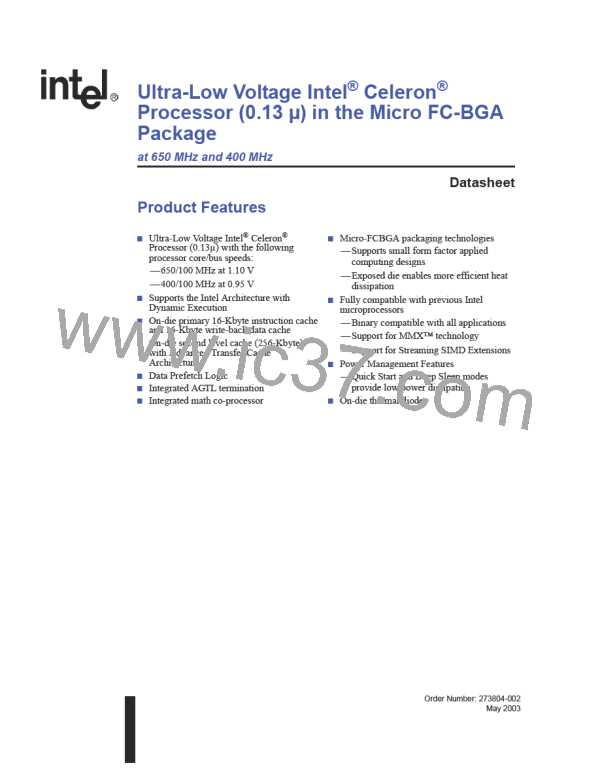Ultra-Low Voltage Intel® Celeron® Processor — 650 MHz and 400 MHz
8.0
Processor Interface
8.1
Alphabetical Signal Reference
8.1.1
A[35:3]# (I/O – AGTL)
The A[35:3]# (Address) signals define a 236-byte physical memory address space. When ADS# is
active, these signals transmit the address of a transaction; when ADS# is inactive, these signals
transmit transaction information. These signals must be connected to the appropriate pins/balls of
both agents on the system bus. The A[35:24]# signals are protected with the AP1# parity signal,
and the A[23:3]# signals are protected with the AP0# parity signal.
On the active-to-inactive transition of RESET#, each processor bus agent samples A[35:3]# signals
to determine its power-on configuration. See P6 Family of Processors Developer’s Manual for
details.
8.1.2
8.1.3
A20M# (I - 1.5V Tolerant)
If the A20M# (Address-20 Mask) input signal is asserted, the processor masks physical address bit
20 (A20#) before looking up a line in any internal cache and before driving a read/write transaction
on the bus. Asserting A20M# emulates the 8086 processor's address wrap-around at the 1-Mbyte
boundary. Assertion of A20M# is only supported in Real mode.
ADS# (I/O - AGTL)
The ADS# (Address Strobe) signal is asserted to indicate the validity of a transaction address on
the A[35:3]# signals. Both bus agents observe the ADS# activation to begin parity checking,
protocol checking, address decode, internal snoop or deferred reply ID match operations associated
with the new transaction. This signal must be connected to the appropriate pins/balls on both agents
on the system bus.
8.1.4
AERR# (I/O - AGTL)
The AERR# (Address Parity Error) signal is observed and driven by both system bus agents, and if
used, must be connected to the appropriate pins/balls of both agents on the system bus. AERR#
observation is optionally enabled during power-on configuration; if enabled, a valid assertion of
AERR# aborts the current transaction.
If AERR# observation is disabled during power-on configuration, a central agent may handle an
assertion of AERR# as appropriate to the error handling architecture of the system.
8.1.5
AP[1:0]# (I/O - AGTL)
The AP[1:0]# (Address Parity) signals are driven by the request initiator along with ADS#,
A[35:3]#, REQ[4:0]# and RP#. AP1# covers A[35:24]#. AP0# covers A[23:3]#. A correct parity
signal is high if an even number of covered signals is low and low if an odd number of covered
signals are low. This allows parity to be high when all the covered signals are high. AP[1:0]#
should be connected to the appropriate pins/balls on both agents on the system bus.
Datasheet
69

 INTEL [ INTEL ]
INTEL [ INTEL ]